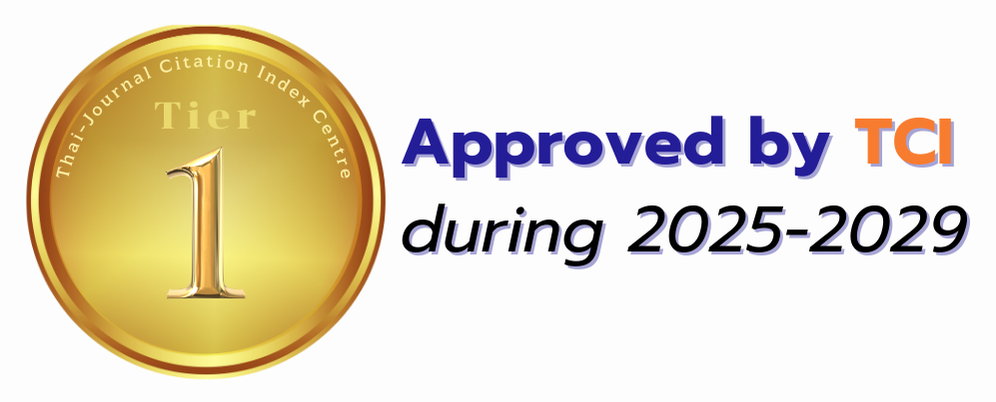Carbon stock in biomass of Peltophorum pterocarpum (DC.) Backer ex K. Heyne in Kasetsart University, Bang Khen campus
DOI:
https://doi.org/10.34044/tferj.2025.9.2.6449Keywords:
Greenhouse gases, large tree, size class, urban forest, urban greeneryAbstract
Background and Objectives: Forest and climate are strongly intertwined. As photosynthesis increases, more atmospheric CO2 is converted into biomass, thereby reducing carbon in the atmosphere and sequestering it within plant tissues both above and belowground. In the global carbon cycle, biomass is an important building block, significant carbon sequestration, and is used to help quantify pools and changes of greenhouse gases (GHGs) from the terrestrial biosphere to the atmosphere associated with land use and land cover changes. In recent decades, rising carbon emissions have become a major global concern, as highlighted in the Kyoto Protocol. Consequently, urban greenery—particularly tree planting—has gained importance as a climate change adaptation and mitigation strategy. The potential benefits and services provided by greenery to the urban ecosystem from a physical point of view include removal GHGs emissions, thermal comfort, improved air quality, energy-use reduction, flood protection and improved runoff-water quality. From a social perspective, green spaces provide health and a range of recreational and psychological benefits, create environmental awareness and encourage positive actions toward climate change. As evident, the carbon sequestration potential of trees in urban landscape revolves around the important biological process of photosynthesis, respiration, and decomposition as the carbon sequestered is the difference between the carbon benefited by photosynthesis and the carbon lost by respiration. Peltophorum pterocarpum is a commonly planted species in heavily motorized urban areas. It tolerates vehicular pollution due to the high ascorbic acid concentration and pH levels in its leaves. It is also the symbolic tree of Kasetsart University, where numerous individuals are widely distributed across the campus. This study therefore focused on evaluating the biomass accumulation and carbon storage of Peltophorum pterocarpum at Kasetsart University, Bang Khen campus. Specifically, we aimed to address the following research questions: (1) What is the current status of biomass accumulation and carbon storage of Peltophorum pterocarpum? and (2) How do these variables differ among size classes?
Material and method: The plotless method was used to observe the tree species of Peltophorum pterocarpum in Kasetsart University, Bangken comapus during August to October 2019. All Peltophorum pterocarpum trees with a diameter at breast height (DBH) ³ 4.5 cm were DBH and total height measured, and the spatial location (UTM) were recorded for every observed tree. The total height was measured using a laser rangefinder, while spatial coordinates were collected using a global positioning system (GPS). We analyzed quantitative stand characteristics, including stem density, basal area, diameter class distribution, aboveground biomass (AGB), belowground biomass (BGB), and total carbon storage (TC). Differences in median carbon storage among size classes were tested using the Kruskal–Wallis nonparametric test. In addition, the relationship between total carbon storage and basal area was examined using Spearman’s rank correlation.
Results and discussion: The total density and basal area of Peltophorum pterocarpum were 1,011 stems and 148.34 m², respectively. The estimated AGB and BGB were 668.65 t and 173.85 t, corresponding to 0.66 ± 0.02 t/stems for AGB and 0.17 ± 0.004 t/stems for BGB. The TC of Peltophorum pterocarpum was 454.95 tC, with an average of 0.45 ± 0.01 tC/stems. The diameter class distribution exhibited a unimodal pattern, indicating that this population represents an even-aged stand. The highest stem density occurred in the 40–50 cm diameter class (305 stems), followed by the 30–40 cm class (293 stems), suggesting that these size classes contribute most to carbon sequestration potential. In contrast, the largest trees (DBH > 60 cm) accounted for the highest proportion of total carbon stock (44.6%), whereas the smallest size class contributed only 0.30%. The Kruskal–Wallis test confirmed significant differences in carbon stock among diameter classes (p < 0.001). Furthermore, Spearman’s correlation analysis revealed a strong positive relationship between basal area and total carbon stock (p < 0.001), indicating that carbon storage increased consistently with size class. This indicated that increasing in pattern of total carbon storage was observed with increasing in size class. These findings highlight the importance of conserving and managing larger trees to sustain carbon storage in Kasetsart University.
Conclusion: This study highlights the significant role of Peltophorum pterocarpum in biomass accumulation and carbon storage within Kasetsart University, Bang Khen campus. The TC of the species was estimated at 454.95 tC, with an average of 0.45 ± 0.01 tC/stems, demonstrating its high potential for carbon sequestration. AGB served as the principal carbon reservoir, while larger trees contributed the most to overall carbon storage, highlighting the need to prioritize their conservation. Furthermore, trees with a DBH of 30–50 cm represent a critical component of future carbon sequestration potential and should be protected. Smaller trees should also be conserved as part of the regeneration class. The findings provide essential field-based biomass and carbon data for improving carbon flux models in urban green spaces. To strengthen these insights, long-term monitoring and studies involving multiple tree species are recommended. Developing a species matrix optimized for carbon storage will be instrumental in advancing urban greening strategies aimed at achieving carbon offsetting targets, conserving biodiversity, and enhancing the provision of ecosystem services in a sustainable manner.
Downloads
References
Behera, S. K., S. Mishra, N. Sahu, N. Manika, S. N. Singh, S. Anto, R. Kumar, R. Husain, A. K. Verma & N. Pandey. 2022. Assessment of carbon sequestration potential of tropical tree species for urban forestry in India. Ecological Engineering 181: 106692. https://doi.org/10.1016/j.ecoleng.2022.106692
Brown, S. & A. E. Lugo. 1992. Above ground biomass estimates for tropical moist forest of the Brazilian amazon. Interciencia 17: 8–18.
Cairns, M. A., S. Brown, E. H. Helmer & G. A. Baumgardner. 1997. Root biomass allocation in the world’s upland forests. Oecologia 111(1): 1–11. https://doi.org/10.1007/s004420050201
Cairns, M. A., I. Olmsted, J. Granados & J. Argaez. 2003. Composition and aboveground tree biomass of a dry semi-evergreen forest on Mexico’s Yucatan Peninsula. Forest Ecology and Management 186(1–3): 125–132. https://doi.org/10.1016/S0378-1127(03)00229-9
Chave, J., C. Andalo, S. Brown, M. A. Cairns, J. Q. Chambers, D. Eamus, H. Fölster, F. Fromard, N. Higuchi & T. Kira. 2005. Tree allometry and improved estimation of carbon stocks and balance in tropical forests. Oecologia 145: 87–99. https://doi.org/10.1007/s00442-005-0100-x
Chave, J., M. Réjou‐Méchain, A. Búrquez, E. Chidumayo, M. S. Colgan, W. B. C. Delitti, A. Duque, T. Eid, P. M. Fearnside & R. C. Goodman. 2014. Improved allometric models to estimate the aboveground biomass of tropical trees. Global Change Biology 20(10): 3177–3190. https://doi.org/10.1111/gcb.12629
Chavan, B. L., & G. B. Rasal. 2010. Sequestered standing carbon stock in selective tree species grown in University campus at Aurangabad, Maharashtra, India. International Journal of Engineering Science and Technology 2(7): 3003–3007.
Chavan, B. L., & G. B. Rasal. 2012. Carbon sequestration potential and status of Peltophorum pterocarpum (DC) K. Heyne. Science Research Reporter 2(1): 51–55.
Choothong S., J. Hatthong, W. N. Nakon, P. Sinumporn. 2022. Study of species and threat status of street trees in an urban landscape in Nakhon Si Thammarat province. Rajabhat Chaing Mai Research Journal 23(1): 198–212. https://doi.org/10.14456/rcmrj.2022.246999 (in Thai)
Kliangsaard, T., L. Puangchit & W. Suanpaga. 2020. Carbon dioxide sequestration and carbon storage in trees at the Santiphap park Bangkok. Thai Journal of Forestry 39(1): 86–96. (in Thai)
Luyssaert, S., E. D. Schulze, A. Börner, A. Knohl, D. Hessenmöller, B. E. Law, P. Ciais & J. Grace. 2008. Old-growth forests as global carbon sinks. Nature 455(7210): 213–215. https://doi.org/10.1038/nature07276
Maneejantra, S., T. Charoenpun, S. Bualert, P. Choomanee, S. Janyasuthiwong & W. Chommon. 2024. Potential Estimation of Secondary Pollutant Formation of BVOC from Peltophorum pterocarpum in Urban Area. Current Applied Science and Technology: e0260120–e0260120. https://doi.org/10.55003/cast.2024.260120
Manuri, S., C. Brack, N. P. Nugroho, K. Hergoualc’h, N. Novita, H. Dotzauer, L. Verchot, C. A. S. Putra & E. Widyasari. 2014. Tree biomass equations for tropical peat swamp forest ecosystems in Indonesia. Forest Ecology and Management 334: 241–253. https://doi.org/10.1016/j.foreco.2014.08.031
Marod, D., P. Dueangkae, S. Sungkaew, P. Racharak, W. Suksavate, S. Uthairatsamee, L. Asanok, T. Kamyo, S. Thinkampheang, S. Hermhuk, P. Kachina, J. Thongsawi, W. Phumpuang, P. Paansri, W. Nuipakdee, P. Nakmuenwai & S. Pattanakiat. 2022. Population structure and spatial distribution of tree species in lower montane forest, Doi Suthep-Pui national park, northern Thailand. Environmental and Natural Resources Journal 20(6): 644–663. 10.32526/ennrj/20/202200139
Mohanta, M. R., A. Mohanta, U. Mohapatra, R. C. Mohanty & S. C. Sahu. 2020. Carbon stock assessment and its relation with tree biodiversity in Tropical Moist Deciduous Forest of Similipal Biosphere Reserve, Odisha, India. Tropical Ecology 61(4): 497–508. https://doi.org/10.1007/s42965-020-00111-8
Nair, P.K.R., & V.D. Nair. 2003. Carbon storage in North American Agroforestry systems. In: Kimble, J., L.S. Heath, R.A Birdsey & R. Lal. (eds.). The Potential of U.S. forest soils to sequester carbon and mitigate the greenhouse effect. CRC Press, Boca Raton, FL, USA, pp. 333–346.
R Core Team. 2025. R: A language and environment for statistical computing. R Foundation for Statistical Computing, Vienna, Austria. Available source: https://www.R-project.org/. (Accessed: July 15, 2025)
Ragula, A., & K. K. Chandra. 2020. Tree species suitable for roadside afforestation and carbon sequestration in Bilaspur, India. Carbon Management 11(4): 369–380. https://doi.org/10.1080/17583004.2020.1790243
Rajah, R. A., K. T. Parthiban, M. Prasanthrajan, M. Vijayabhama, P. Patil, I. Sekar, S. R. Varadha, K. S. Umesh, P. S. S. Devanand, B. Sivakumar, R. B. Nilav, P. Niazi & Y. K. Virendra. 2025. Evaluation of air pollution tolerance index of selected tree species to combat air pollution in urban areas of Mettupalayam, Tamil Nadu, India. Environmental Pollutants and Bioavailability 37(1): 2524085. https://doi.org/10.1080/26395940.2025.2524085
Rianthakool, L., J. Yingdee, T. Chumsangsri, C. N. Takuathung, P. Diloksumpun, T. Lakkanasri, C. Tosophon & N. Intim. 2024. The study of 3D modelling of Peltophorum pterocarpum with terrestrial laser scanner. Thai Science and Technology Journal 32(5): 79–91. doi: 10.14456/tstj.2024.40. (in Thai)
San-José, M., L. Werden, C. J. Peterson, F. Oviedo-Brenes & R. A. Zahawi. 2021. Large tree mortality leads to major aboveground biomass decline in a tropical forest reserve. Oecologia 197(3): 795–806. https://doi.org/10.1007/s00442-021-05048-w
Shafiq, M., & M. Z. Iqbal. 2007. Germination and seedling behaviours of seeds of Peltophorum pterocarpum DC Baker Ex K. Heyne growing under motor vehicle emission. Turkish Journal of Botany 31(6): 565–570.
Schimel, D., B. B., Stephens, & J. B. Fisher. 2015. Effect of increasing CO2 on the terrestrial carbon cycle. Proceedings of the National Academy of Sciences 112(2): 436–441. https://doi.org/10.1073/pnas.1407302112
Stephenson, N. L., A. J. Das, R. Condit, S. E. Russo, P. J. Baker, N. G. Beckman, D. A. Coomes, E. R. Lines, W. K. Morris, N. Rüger, E. Álvarez, C. Blundo, S. Bunyavejchewin, G. Chuyong, S. J. Davies, Á. Duque, C. N. Ewango, O. Flores, J. F. Franklin, H. R. Grau, Z. Hao, M. E. Harmon, S. P. Hubbell, D. Kenfack, Y. Lin, J.-R. Makana, A. Malizia, L. R. Malizia, R. J. Pabst, N. Pongpattananurak, S.-H. Su, I-F. Sun, S. Tan, D. Thomas, P. J. van Mantgem, X. Wang, S. K. Wiser & M. A. Zavala. 2014. Rate of tree carbon accumulation increases continuously with tree size. Nature 507(7490): 90–93. https://doi.org/10.1038/nature12914
van der Velden, N., J. F. Slik, Y. H. Hu, G. Lan, L. Lin, X. Deng & L. Poorter. 2014. Monodominance of Parashorea chinensis on fertile soils in a Chinese tropical rain forest. Journal of Tropical Ecology 30(4): 311–322. doi:10.1017/S0266467414000212
Velasco, E., M. Roth, L. Norford & L. T. Molina. 2016. Does urban vegetation enhance carbon sequestration? Landscape and urban planning 148: 99–107. https://doi.org/10.1016/j.landurbplan.2015.12.003
Yordanov, I., T. Tsonev,V. Goltsev, M. Merakchiiska-Nikolova & K. Georgieva. 1997. Gas exchange and chlorophyll fluorescence during water and high temperature stresses and recovery. Probable protective effect of carbamide cytokinin 4-PU30. Photosynthetica 33(3): 423–431.







.png)





